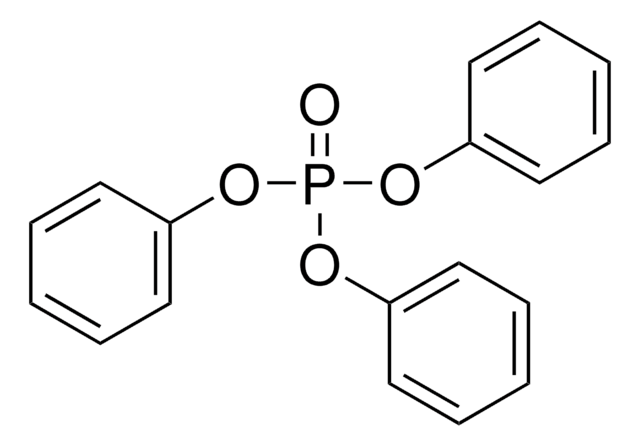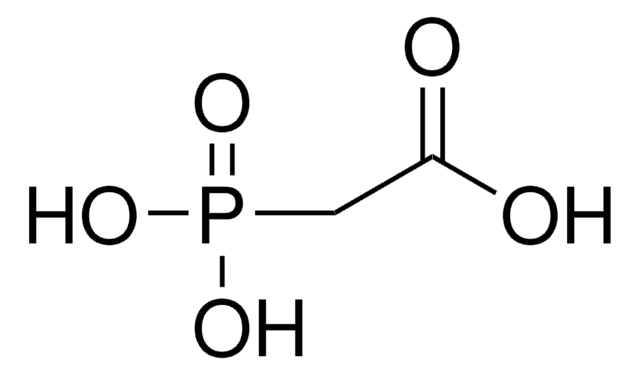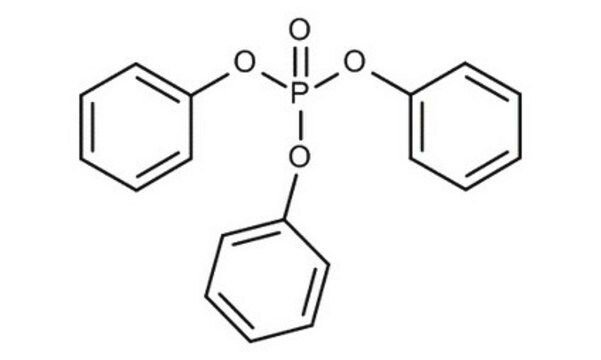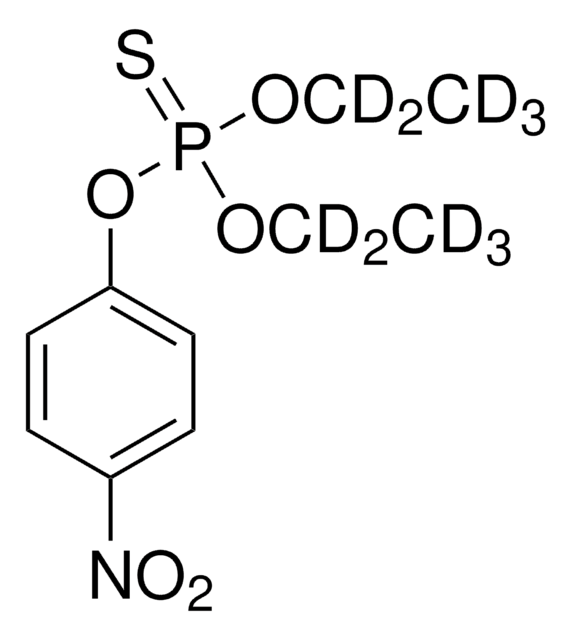05498
Triphényl phosphate
TraceCERT®, 31P-qNMR Standard, Manufactured by: Sigma-Aldrich Production GmbH, Switzerland
About This Item
Produits recommandés
Pression de vapeur
1.3 mmHg ( 200 °C)
Niveau de qualité
Gamme de produits
TraceCERT®
Qualité
TraceCERT®
Durée de conservation
limited shelf life, expiry date on the label
Fabricant/nom de marque
Manufactured by: Sigma-Aldrich Production GmbH, Switzerland
Technique(s)
qNMR: suitable
Point d'ébullition
244 °C/10 mmHg (lit.)
Pf
48-50 °C (lit.)
Application(s)
cleaning products
cosmetics
flavors and fragrances
food and beverages
personal care
pharmaceutical
Chaîne SMILES
O=P(Oc1ccccc1)(Oc2ccccc2)Oc3ccccc3
InChI
1S/C18H15O4P/c19-23(20-16-10-4-1-5-11-16,21-17-12-6-2-7-13-17)22-18-14-8-3-9-15-18/h1-15H
Clé InChI
XZZNDPSIHUTMOC-UHFFFAOYSA-N
Vous recherchez des produits similaires ? Visite Guide de comparaison des produits
Description générale
Certified content by quantitative NMR incl. uncertainty and expiry date are given on the certificate.
Download your certificate at: http://www.sigma-aldrich.com
Check out our entire range of quantitative NMR standards (qNMR standards)
Application
- Triphenyl phosphate reagent in wastewater treatment: Triphenyl phosphate (TPP) is applied in advanced oxidation processes to enhance the removal of pollutants from wastewater, utilizing Myriophyllum biochar-supported Mn/Mg nano-composites as catalysts to activate periodate for efficient TPP degradation (Xie et al., 2024).
- Organic phosphate compound in material science: TPP is utilized in the synthesis and modification of LDH hollow polyhedra by polydopamine, demonstrating its versatile application in materials science for developing new composite materials (Hou et al., 2024).
Autres remarques
The collision cross section (CCS) measurement was provided by Waters Corporation, using the SYNAPT XS mass spectrometer.
For a description and overview of how ion mobility enables the measurement of the CCS of an ion visit ims.waters.com.
Further information on the SYNAPT XS mass spectrometer can be found on the IMS microsite and product webpage.
TWCCS measurements are expected to be within 2% of this reference value.
P/N 05498 is part of the Waters Extractables & Leachables UNIFI scientific library which can be downloaded from Waters Marketplace.
Produits recommandés
Informations légales
Vous ne trouvez pas le bon produit ?
Essayez notre Outil de sélection de produits.
Mention d'avertissement
Warning
Mentions de danger
Conseils de prudence
Classification des risques
Aquatic Acute 1 - Aquatic Chronic 1
Code de la classe de stockage
11 - Combustible Solids
Classe de danger pour l'eau (WGK)
WGK 2
Point d'éclair (°F)
428.0 °F - closed cup
Point d'éclair (°C)
220 °C - closed cup
Faites votre choix parmi les versions les plus récentes :
Déjà en possession de ce produit ?
Retrouvez la documentation relative aux produits que vous avez récemment achetés dans la Bibliothèque de documents.
Les clients ont également consulté
Articles
The use of CRMs for the NMR quantification of phosphorylated organic compounds and metabolites offers several advantages as it is based on a signal comparison of the analyte with an internal or external reference standard.
In certain cases, 1H qNMR reaches its limits, especially regarding the certification of complex and larger molecules. However, new fields of application often also bring along the presence of heteroatoms, namely 31P and 19F. We therefore introduced 3 CRMs for 19F qNMR with traceability to the SI.
Contenu apparenté
ChemisTwin is your new online digital assistant for NMR result interpretation. It will save you time by automating the interpretation of routine NMR analysis for structure confirmation as well as quantitative NMR (qNMR) measurements using qNMR eRMs from our verified electronic Reference Materials database.
Notre équipe de scientifiques dispose d'une expérience dans tous les secteurs de la recherche, notamment en sciences de la vie, science des matériaux, synthèse chimique, chromatographie, analyse et dans de nombreux autres domaines..
Contacter notre Service technique










